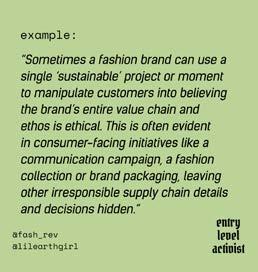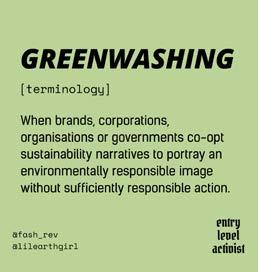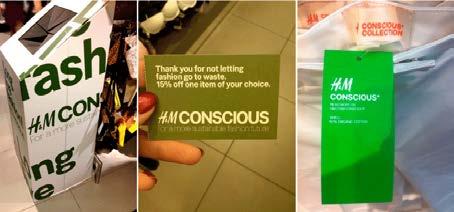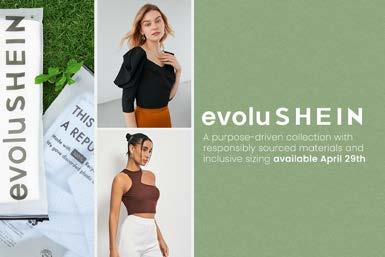
8 minute read
5 We all should be activists
TIME 40 min
Objective
Advertisement
The objective of this activity is to develop understanding of how activist organisations and campaigns are positively influencing the fashion industry, and what specific issues they are focused on to motivate people to join these campaigns.
Description
Participants are asked to search the Internet to gather information about non-profit organisations or campaigns that target the negative effects of the fashion industry. They are tasked to gather information about what these organisations’ and campaigns’ work or content consists of, and the ways in which they invite people to get involved in their activities. Based on a set of prepared questions, they are asked to present the ways in which these organisations and campaigns identify and attempt to address problems in the fashion industry.
TOPICS Activism
TOOLS computer/ laptop/ smartphone/ tablet with access to the Internet blackboard or flipchart and chalk or pens
Activity
Divide the participants into groups of 2 to 5 people. Let them answer the following questions and, if they want, they can write them down on the blackboard of flipchart:
Have you heard about any negative impacts of the fashion industry on the environment or people?
Who in the world do you think can challenge these impacts and make positive change?
Who are they?
Inspirational individuals (influencers)?
Ordinary individuals - each of us? Groups of people working together on campaigns or in organisations? Governments? Companies? etc.
Do you know of any organisations or campaigns that try to challenge the negative effects of the fashion industry? How do they try to do this?
An example of an organisation challenging the negative impacts of the fashion industry:
Fashion Revolution Fashion Revolution was launched as a reaction to the collapse of the Rana Plaza clothing factory complex in Dhaka, Bangladesh on 24 April 2013, where 1138 mostly female factory workers were crushed to death in a neglected and unstable building. The goal of this global movement is to transform the fashion industry through transparency. Since Fashion Revolution was launched, it has mobilise publics to participate in #WhoMadeMyClothes happenings worldwide, in person and on social networks.
Thanks to Fashion Revolution Week, organised every April, journalists and influencers are constantly calling for systematic change within the fashion industry.
Fashion Revolution is also known for its annual Fashion Transparency Index, which evaluates the transparency of the world's biggest fashion brands. The organisation is also contributing to the improvement of working conditions of garment workers, most recently through the Good Clothes, Fair Pay campaign.
2) An organisation/campaign fighting for a decent minimum or living wage for garment workers.
3) An organisation/campaign trying to tackle the animal rights issues related to clothing and footwear production (for example for fur and leather production, etc.).
4) An organisation/campaign challenging the impacts of the fashion industry on the environment.
Next, for 10 minutes, ask the members of each group to use their smartphones/ laptops/tablets to find organisations or campaigns that challenge five different negative impacts of the fashion industry. Each member could focus on one of the following:
1) An organisation/campaign focused on the human rights of garment workers.
5) An organisation/campaign that encourages consumers to take action in order to create positive solutions to issues caused by the fashion industry.
Then ask the groups to briefly present their findings to their peers (verbally and/ or using the whiteboard) and then ask them the following questions:
• Can you explain the difference between an organisation and a campaign?
• What organisations and what campaigns have you found?
How difficult was it to find organisations for each topic?
• Do any of these organisations work in your area (city, state)? Where are their nearest offices?
What results have these organisations or campaigns achieved so far?
• Which organisation would you join as a volunteer or ambassador? What would motivate you to do this?
What activities that you found interested you most? Why? Do they share your values? Were you already interested in those issues?
Methodology Tips
• If the participants are struggling to find local organisations, they can search for global ones that have offices in their country. Suggest that they search for organisations and campaigns in English, and help them with their English if they ask.
Tips For Online
In the online version, participants use a platform like Whiteboard, Mural or Miro instead of a flipchart to share the information they have found about organisations or campaigns.
Time
50 min
Objective
The objective of this activity is to develop skills to recognise greenwashing in fashion brands' marketing and to gain skills to identify and verify any information they provide.
Description
Participants are given 4 examples of sustainable fashion advertising and discuss their goals, missions, credibility and impact on the environment and people. Next, they try to find out which campaigns are socially and environmentally conscious and which use greenwashing techniques. The main aim is to encourage participants to start to think critically about the current green / sustainable campaigns of fashion companies that are targeted on them.
Topics
Sustainable fashion advertising
Greenwashing
Verification
TOOLS
Cards with sustainable fashion advertising
Smartphone or laptop with an internet access
Pen and paper
Activity
Divide the participants into groups of 3-5 members and ask them to write down their answered to the following questions:
Do you follow fashion advertising campaigns?
What is your opinion about them?
Do you find a lot of fashion ads in your social media space?
Do you remember some of them?
How do you usually interact with fashion ads?
Have you ever come across "green" or “sustainable” fashion ads?

Do you think their “green” and “sustainable” claims are credible and trustworthy?

Can these claims be verified? How?
Why do you think companies are interested in looking sustainable?
Do you think that there are companies which are actually sustainable?
Can you name some?
Can you explain what you think is sustainable about them?
Have you come across the term “greenwashing”? What do you think it means?
Next, give each group a card with the definition of “greenwashing”. You can find it at the end of this activity.
Next, give each group a card detailing a green or sustainable fashion campaign. Ask the group members to spend 10 minutes researching on the Internet (on brand websites, reading articles from reliable sources, etc.) and then to debate the credibility and trustworthiness of their campaign. Ask them to write down their findings.
The following questions can help them to to think critically about the campaign they have been given:
Are the campaign’s claims about environmental benefits confirmed by the facts?
Does the brand use terms like ‘eco’, ‘green’ or ‘natural’ with or without precise definitions?
What certificates does the brand rely on to prove it is green or sustainable?
Are they traceable and credible?
How does the brand present itself on social media?
What's the tone or voice of their campaign? (add a couple of examples of what this means?)
What is the brand’s reputation today and what was it like in the past?
Is the brand known for fairly treating the people who work in its supply chains?
Does the brand have a history of unfair treatment of its garment workers?
Is the brand transparent? Do they publish information about their clothes’ production, garment workers or pricing?
Can you identify information that they do not disclose (e.g. they are transparent about parts of their supply chains, and not all)?
How clear is it to you that the brand is truly environmentally responsible?
Next, ask each group to write their findings and ideas about their brand’s advertising campaign (approx 30 minutes) on a sheet of paper.
Then, ask each group to bring their paper to the front of the room to show what they have found. After these presentations, start a wider discussion using the following questions as prompts:
What do campaigns have in common and how are they different?
Was it possible to find facts confirming the authenticity of your brand’s green / sustainable fashion campaign?
How can you verify the green or sustainable claims that a brand makes?
Where can you find out more about greenwashing?
Will you try to verify claims about green or sustainable fashion in future purchase decisions?
Ask the participants to evaluate what they found out and to discuss their opinions about green, sustainable and greenwashed fashion campaigns they are familiar with. This is a space for open discussion.
Finally, make sure to emphasise that there is no need to feel guilty about having supported greenwashing campaigns in the past.Motivate them to try to find more information about any fashion goods they purchase in the future and their related campaigns. Tell them that greenwashing is happening everywhere, in every industry, and that it is sometimes very hard to recognise despite all our efforts.
Methodology Tips
• Groups can share the information they find on whiteboards or online (see below).
• Show them this guide on how to verify online information.
• For deeper exploration of the concept of transparency in fashion supply chains, suggest they read about it here.
Tips For Online
In the online version of this activity, participants can use the online platforms Whiteboard, Mural or Miro to share the information they have found about the brands and their campaigns.
Resources
1. card with the definition of greenwashing
2. cards detailing green or sustainable fashion campaigns
“With us, it’s super simple to find out where your clothes were made. We believe that being transparent is an important part of becoming more sustainable. Sharing knowledge about our business and how we make our clothes gives you more power as a customer. The more you know, the more informed decisions you can make. We want you to feel confident that the products you buy from us are made both responsibly and sustainably. When you click on an H&M product, you can find out which materials the product is made from, which countries it was produced in and which suppliers and factories we partnered with to make it. You can find all this, as well as information on how to recycle your clothes in our Product Background section on the product's page. The only exception is products made before our tracking system was developed.”
Source: https://www2.hm.com/en_asia1/sustainability-at-hm/our-work/transparent.html

“"We are committed to building a more responsible fashion ecosystem," said Adam Whinston, Global Head of Environmental, Social and Governance at SHEIN. "Launching evoluSHEIN is one important step in our sustainability commitments this year, which touches on each of our key focus areas - protecting the environment, supporting communities, and empowering entrepreneurs. We invite all our partners and customers to join us in the journey."
Source: https://www.sheingroup.com/shein-launches-evolushein-new-clothing-line/

Levi’s – “Buy Better, Wear Longer”
“Made better, buy better, wear longer, but less, waste less and change for good”: this is the mantra on which the “Buy better, wear longer” campaign launched in 2021 by Levi’s is based. The protagonists are young people who can inspire the younger generations, such as Jaden Smith, Xive Bastida, and Emma Chamberlain, spokespersons for the brand’s commitment to creating quality garments that last over time and that respect the planet at every stage of production. “Levi’s denim is meant to be worn for generations, not seasons. With this campaign we want to encourage consumers to be more aware of their clothing choices,” said Jennifer Sey, president of the brand. The campaign also includes Levi’s commitment to adopt more sustainable production, which includes eco-friendly materials and technologies and significant savings in terms of unused water. To be cool and respectful together, but also as individuals, rethinking the fashion system.”
Source: https://www.theitalianreve.com/the-green-side-the-most-iconic-sustainable-fashioncampaigns/#:~:text=Levi's%20%E2%80%93%20%E2%80%9CBuy%20Better%2C%20Wear,2021%20by%20 Levi's%20is%20based



